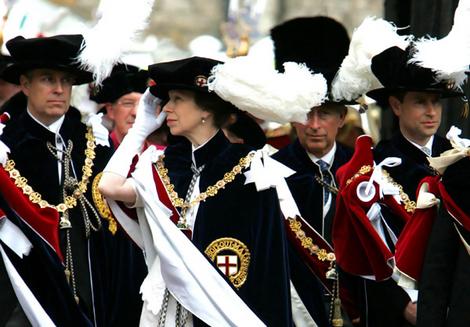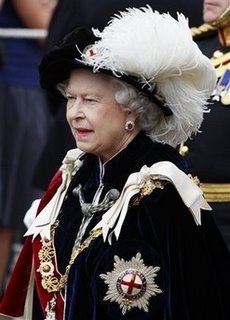
Each year in June a procession and service take place at Windsor Castle for the Order of the Garter.
This year’s service takes place on Monday 15 June.
The Order is the senior and oldest British Order of Chivalry, founded by Edward III in 1348.
New appointments to the Order of the Garter are usually announced on St. George’s Day (23 April) but the chivalric and installation ceremonies take place in June, on the Monday of Royal Ascot week, known as Garter Day.
If there are new Companions of the Order of the Garter, The Queen formally invests them with the insignia at a Chapter of the Order in the Throne Room of Windsor Castle.
After lunch the Knights process on foot to a service in St. George’s Chapel, wearing their blue velvet robes, known as mantels, and black velvet hats with white plumes.

The processional route is through the Upper, Middle and Lower Wards of the castle to St. George’s Chapel.
The colourful procession is led by the Constable and Governor of Windsor Castle and the Military Knights of Windsor.
On reaching the chapel there is a short service.
On emerging from the Great West Door of the Chapel, the Sovereign and the other members of the Order return in carriages and cars to the Upper Ward of the castle.
The Queen attends the service along with other members of the Royal Family in the Order, including The Duke of Edinburgh, The Prince of Wales, Prince William, The Duke of York, The Earl of Wessex, The Princess Royal, The Duke of Gloucester, The Duke of Kent and Princess Alexandra.

More about the Order of the Garter:
The Garter ceremonial dates from 1948, when formal installation was revived by King George VI for the first time since 1805.
The Order of the Garter is the most senior and the oldest British Order of Chivalry and was founded by Edward III in 1348.
The Order, consisting of the King and twenty-five knights, honours those who have held public office, who have contributed in a particular way to national life or who have served the Sovereign personally.
The patron saint of the Order is St George (patron saint of soldiers and also of England) and the spiritual home of the Order is St George’s Chapel, Windsor.
Every knight is required to display a banner of his arms in the Chapel, together with a helmet, crest and sword and an enamelled stallplate.
These ‘achievements’ are taken down on the knight’s death and the insignia are returned to the Sovereign. The stallplates remain as a memorial and these now form one of the finest collections of heraldry in the world.
The insignia of the Order have developed over the centuries, starting with a garter and badge depicting St George and the Dragon. A collar was added in the sixteenth century, and the star and broad riband in the seventeenth century.
Although the collar could not be decorated with precious stones (the statutes forbid it), the other insignia could be decorated according to taste and affordability. George IV, well-known for his vanity, left 55 different Garter badges of varying styles.
Over the years, a number of knights have been ‘degraded’ (for the crimes of heresy, treason or cowardice) or even executed – such as Lord Scrope of Masham (a childhood friend of Henry V), and the 3rd Duke of Buckingham in 1521. Charles I wore his Order (ornamented with over 400 diamonds) to his execution in 1649.
From the eighteenth century to 1946, appointments to the Order (and to the Order of the Thistle) were made on advice from government.
Today, the Order has returned to its original function as a mark of Royal favour; Knights of the Garter are chosen personally by the Sovereign to honour those who have held public office, who have contributed in a particular way to national life or who have served the Sovereign personally.
The number of knights is limited to 24, plus Royal knights. For much of its history, the Garter was limited to the aristocracy, but today the knights are from varied backgrounds. If there are vacancies in the Order, appointments are announced on St George’s Day (23 April).
Every June, the Knights of the Garter gather at Windsor Castle, where new knights take the oath and are invested with the insignia. A lunch is given in the Waterloo Chamber, after which the knights process to a service in St George’s Chapel, wearing their blue velvet robes (with the badge of the Order – St George’s Cross within the Garter surrounded by radiating silver beams – on the left shoulder) and black velvet hats with white plumes.
The Queen (whose father George VI appointed her and her husband to the Order in 1947) attends the service as Sovereign of the Order. Other members of the Royal Family in the Order also attend, including The Duke of Edinburgh, The Prince of Wales and The Princess Royal.
During the Middle Ages ladies were associated with the Order, although unlike today they did not enjoy full membership. One of the last medieval ladies to be honoured was Lady Margaret Beaufort, mother of Henry VII and grandmother of Henry VIII.
After her death in 1509 the Order remained exclusively male, except for reigning queens as Sovereign of the Order, until 1901 when Edward VII made Queen Alexandra a lady of the Order.
In 1987, The Queen decided that women should be eligible for the Garter in the same way as men. Women are therefore included in this number and currently Lady Thatcher (formerly Margaret Thatcher, first female prime minister of Great Britain) and Lady Soames (the youngest daughter of Sir Winston Churchill, also a holder of the Order of the Garter) hold this honour.

